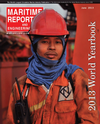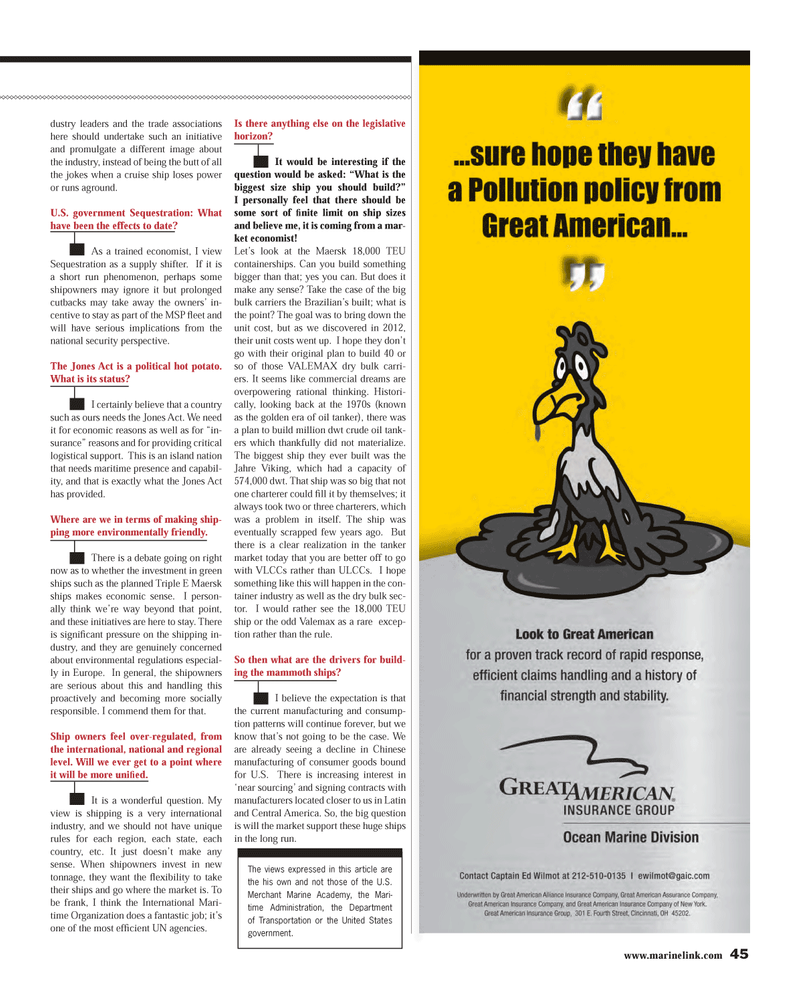
Page 45: of Maritime Reporter Magazine (June 2013)
Annual World Yearbook
Read this page in Pdf, Flash or Html5 edition of June 2013 Maritime Reporter Magazine
www.marinelink.com 45dustry leaders and the trade associations here should undertake such an initiative and promulgate a different image about the industry, instead of being the butt of all the jokes when a cruise ship loses power or runs aground.U.S. government Sequestration: What have been the effects to date? As a trained economist, I view Sequestration as a supply shifter. If it is a short run phenomenon, perhaps some shipowners may ignore it but prolonged cutbacks may take away the owners? in- centive to stay as part of the MSP ß eet and will have serious implications from the national security perspective.The Jones Act is a political hot potato. What is its status? I certainly believe that a country such as ours needs the Jones Act. We need it for economic reasons as well as for ?in-surance? reasons and for providing critical logistical support. This is an island nation that needs maritime presence and capabil-ity, and that is exactly what the Jones Act has provided. Where are we in terms of making ship- ping more environmentally friendly. There is a debate going on right now as to whether the investment in green ships such as the planned Triple E Maersk ships makes economic sense. I person-ally think we?re way beyond that point, and these initiatives are here to stay. There is signiÞ cant pressure on the shipping in- dustry, and they are genuinely concerned about environmental regulations especial-ly in Europe. In general, the shipowners are serious about this and handling this proactively and becoming more socially responsible. I commend them for that.Ship owners feel over-regulated, from the international, national and regional level. Will we ever get to a point where it will be more uni Þ ed. It is a wonderful question. My view is shipping is a very international industry, and we should not have unique rules for each region, each state, each country, etc. It just doesn?t make any sense. When shipowners invest in new tonnage, they want the ß exibility to take their ships and go where the market is. To be frank, I think the International Mari-time Organization does a fantastic job; it?s one of the most efÞ cient UN agencies. Is there anything else on the legislative horizon? It would be interesting if the question would be asked: ?What is the biggest size ship you should build?? I personally feel that there should be some sort of Þ nite limit on ship sizes and believe me, it is coming from a mar- ket economist! Let?s look at the Maersk 18,000 TEU containerships. Can you build something bigger than that; yes you can. But does it make any sense? Take the case of the big bulk carriers the Brazilian?s built; what is the point? The goal was to bring down the unit cost, but as we discovered in 2012, their unit costs went up. I hope they don?t go with their original plan to build 40 or so of those VALEMAX dry bulk carri- ers. It seems like commercial dreams are overpowering rational thinking. Histori-cally, looking back at the 1970s (known as the golden era of oil tanker), there was a plan to build million dwt crude oil tank-ers which thankfully did not materialize. The biggest ship they ever built was the Jahre Viking, which had a capacity of 574,000 dwt. That ship was so big that not one charterer could Þ ll it by themselves; it always took two or three charterers, which was a problem in itself. The ship was eventually scrapped few years ago. But there is a clear realization in the tanker market today that you are better off to go with VLCCs rather than ULCCs. I hope something like this will happen in the con-tainer industry as well as the dry bulk sec-tor. I would rather see the 18,000 TEU ship or the odd Valemax as a rare excep- tion rather than the rule.So then what are the drivers for build- ing the mammoth ships? I believe the expectation is that the current manufacturing and consump-tion patterns will continue forever, but we know that?s not going to be the case. We are already seeing a decline in Chinese manufacturing of consumer goods bound for U.S. There is increasing interest in ?near sourcing? and signing contracts with manufacturers located closer to us in Latin and Central America. So, the big question is will the market support these huge ships in the long run. The views expressed in this article are the his own and not those of the U.S. Merchant Marine Academy, the Mari- time Administration, the Department of Transportation or the United States government.MR #6 (42-49).indd 45MR #6 (42-49).indd 455/31/2013 9:11:32 AM5/31/2013 9:11:32 AM

 44
44

 46
46
